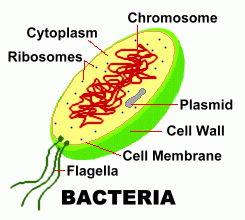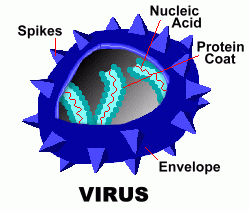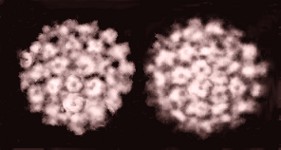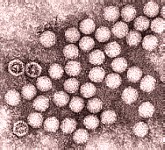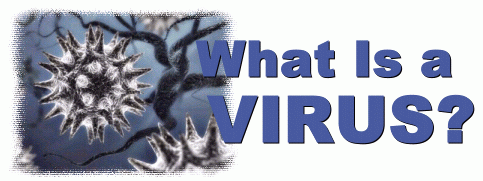 Viruses are unusual, incredibly tiny particles that are either living or non-living organisms, depending on your definition of 'life'. If they're floating around in the air or sitting on a rock, they're inert ... not alive at all. They don't do any of the normal things we associate with living organisms. But if they come into contact with a suitable living cell, they infect and take over the cell, and reproduce themselves. 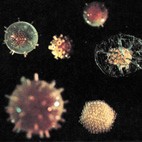 A virus is a tiny bundle of genetic material - either DNA or RNA - carried in a shell called a viral coat, or capsid, which is made up of protein. Some viruses have an additional layer around this coat called an envelope. When a virus particle enters a cell and begins to reproduce itself, this is called a viral infection. The virus is usually very, very small compared to the size of a living cell. The information carried in the virus's DNA allows it to take over the operation of the cell, converting it to a factory to make more copies of itself. For example, the polio virus can make over one million copies of itself inside a single, infected human intestinal cell. The Differences Between Bacteria and Viruses
All viruses only exist to make more viruses. With the possible exception of bacterial viruses, which can kill harmful bacteria, all viruses are considered harmful, because their reproduction causes the death of the cells which the viruses entered. If a virus contains DNA, it inserts its genetic material into the host cell's DNA. If the virus contains RNA, it must first turn its RNA into DNA using the host cell's machinery, before inserting it into the host DNA. Once it has taken over the cell, viral genes are then copied thousands of times, using the machinery the host cell would ordinarily use to reproduce its own DNA. Then the host cell is forced to encapsulate this viral DNA into new protein shells; the new viruses created are then released, destroying the cell. All living things are susceptible to viral infections ... plants, animals, or bacteria can all be infected by a virus specific for that type of organism. Moreover, within an individual species there may be a hundred or more different viruses which can infect that species alone. There are viruses which infect only humans (for example, smallpox), viruses which infect humans and one or two additional kinds of animals (for example, influenza), viruses which infect only a certain kind of plant (for example, the tobacco mosaic virus), and some viruses which infect only a particular species of bacteria (for example, the bacteriophage which infects E. coli). Sometimes when a virus reproduces, mutations occur. The offspring that have been changed by the mutation may no longer be infectious. But a virus replicates itself thousands of times, so there will usually be some offspring that are still infectious, but sufficiently different from the parent virus so that vaccines no longer work to kill it. The influeza virus can do this very well, which is why flu vaccines for last year's flu don't work the next year. The common cold virus changes so quickly that vaccines are useless; the cold you have today will be a different strain than the cold you had last month!  The Epstein-Barr virus (the larger dark sphere in the photo at the left) infects up to 95 percent of adults, which means you probably have it. This virus is normally picked up in early childhood. However, most people don't know they have it; usually it just sits in your body quietly. In some people, however, the virus becomes active, usually in the teenage years. The virus causes the sickness called mononucleosis, which can be spread by saliva (giving it the nickname 'the kissing disease').
The Epstein-Barr virus (the larger dark sphere in the photo at the left) infects up to 95 percent of adults, which means you probably have it. This virus is normally picked up in early childhood. However, most people don't know they have it; usually it just sits in your body quietly. In some people, however, the virus becomes active, usually in the teenage years. The virus causes the sickness called mononucleosis, which can be spread by saliva (giving it the nickname 'the kissing disease').
DNA-containing Viruses:
RNA-containing Viruses:
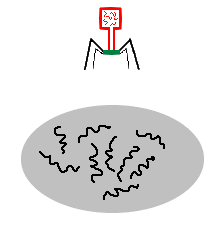
Bacteriophages:  Some varieties of viruses attack only bacteria. These types are called bacteriophages. The bacteriophage lands on the bacterium and cuts a hole in the cell wall with its 'injection tube'. It then injects its genetic material into the bacterium. These inserted viral genes take over the bacterium's genetic machinery, and tell the bacterium to begin making new virus parts. Some varieties of viruses attack only bacteria. These types are called bacteriophages. The bacteriophage lands on the bacterium and cuts a hole in the cell wall with its 'injection tube'. It then injects its genetic material into the bacterium. These inserted viral genes take over the bacterium's genetic machinery, and tell the bacterium to begin making new virus parts.These parts come together to make whole new viruses inside the bacterium. Then the bacterium bursts open and dies, releasing all those new viruses to infect more cells! You can see this process in the animation above right. An actual photomicrograph of a bacteriophage in action is shown above left. Dealing with Viral Attacks Antibiotics do not harm a virus; for this reason, many treatments for the "flu" or the common cold virus (for example) just help ease the symptoms; they don't kill the virus. In your body, the immune system can react to the surface of virus particles, and produce neutralizing antibodies.Vaccines can be made from virus particles and injected into your body; the small infection that results won't make you sick, but it allows your body's immune system to learn to recognize the virus, so that if you are infected later with the real thing, your body can fight it. However, mutations within viral DNA cause their surfaces to continually change shape, so that the antibodies may not continue to be effective. This is particularly true with the common cold virus, which is constantly changing, so a vaccine won't be much use. The HIV virus is particularly dangerous because it attacks the cells of the immune system ... the system that helps fight diseases! Although HIV does not itself directly cause the condition known as AIDS, the eventual death of the immune cells in the body due to infection with HIV allows other infections to harm a person. It may soon be possible to design small compounds which bind to the surface of a virus and prevent it from entering a cell. This research is currently under way. One sneeze can generate an aerosol of enough cold viruses to infect thousands of people! |
